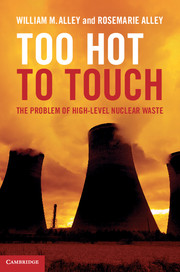Book contents
- Frontmatter
- Contents
- Acknowledgments
- List of units
- List of abbreviations
- Introduction
- Part I The problem
- 1 The awakening
- 2 Brainstorming
- 3 The ocean as a dumping ground
- 4 Radioactivity and atomic energy
- 5 The Cold War legacy
- 6 The peaceful atom and its wastes
- 7 Recycling
- 8 Dry cask storage
- 9 Interim storage
- 10 A can of worms
- 11 WIPP
- Part II The mountain
- Part III No solution in sight
- Appendix Discussion questions
- References
- Index
10 - A can of worms
from Part I - The problem
Published online by Cambridge University Press: 05 February 2013
- Frontmatter
- Contents
- Acknowledgments
- List of units
- List of abbreviations
- Introduction
- Part I The problem
- 1 The awakening
- 2 Brainstorming
- 3 The ocean as a dumping ground
- 4 Radioactivity and atomic energy
- 5 The Cold War legacy
- 6 The peaceful atom and its wastes
- 7 Recycling
- 8 Dry cask storage
- 9 Interim storage
- 10 A can of worms
- 11 WIPP
- Part II The mountain
- Part III No solution in sight
- Appendix Discussion questions
- References
- Index
Summary
Newspapers are unable, seemingly, to discriminate between a bicycle accident and the collapse of civilization
Attributed to George Bernard ShawOn the evening of July 6, 1994, Dave Prudic arrived in the town of Needles, California. True to form, the temperature hovered around 100 degrees, yet it felt almost cool compared to the afternoon high of 108 degrees. Among meteorologists, Needles was the record-breaker – often registering the highest summertime high in the Nation, and occasionally for the world, as well as the highest low. It didn't cool down much in Needles during the summer months.
The 1994 population was around 4,500. Many worked for the BNSF railroad, as the town was a crew change point. Aside from the train coming in, not much was happening in Needles these days. Then again, not much had ever happened in this small western town sitting on the California side of the Colorado River and getting its name from a group of pointed rocks on the Arizona side.
The town has a couple of claims to fame. Charles Schultz, creator of the Peanuts cartoon, had lived in Needles as a child. Schultz had gone on to immortalize the town with Snoopy’s brother, Spike, who lived in the desert outside Needles and spent his days lying on rocks talking to cacti. Needles also made news in 2008 when it threatened to leave California and become part of Nevada or Arizona. The town shakers and movers weren’t particularly choosy about which State would take them. The problem was, Needles was on the wrong side of the river.
- Type
- Chapter
- Information
- Too Hot to TouchThe Problem of High-Level Nuclear Waste, pp. 131 - 151Publisher: Cambridge University PressPrint publication year: 2012



